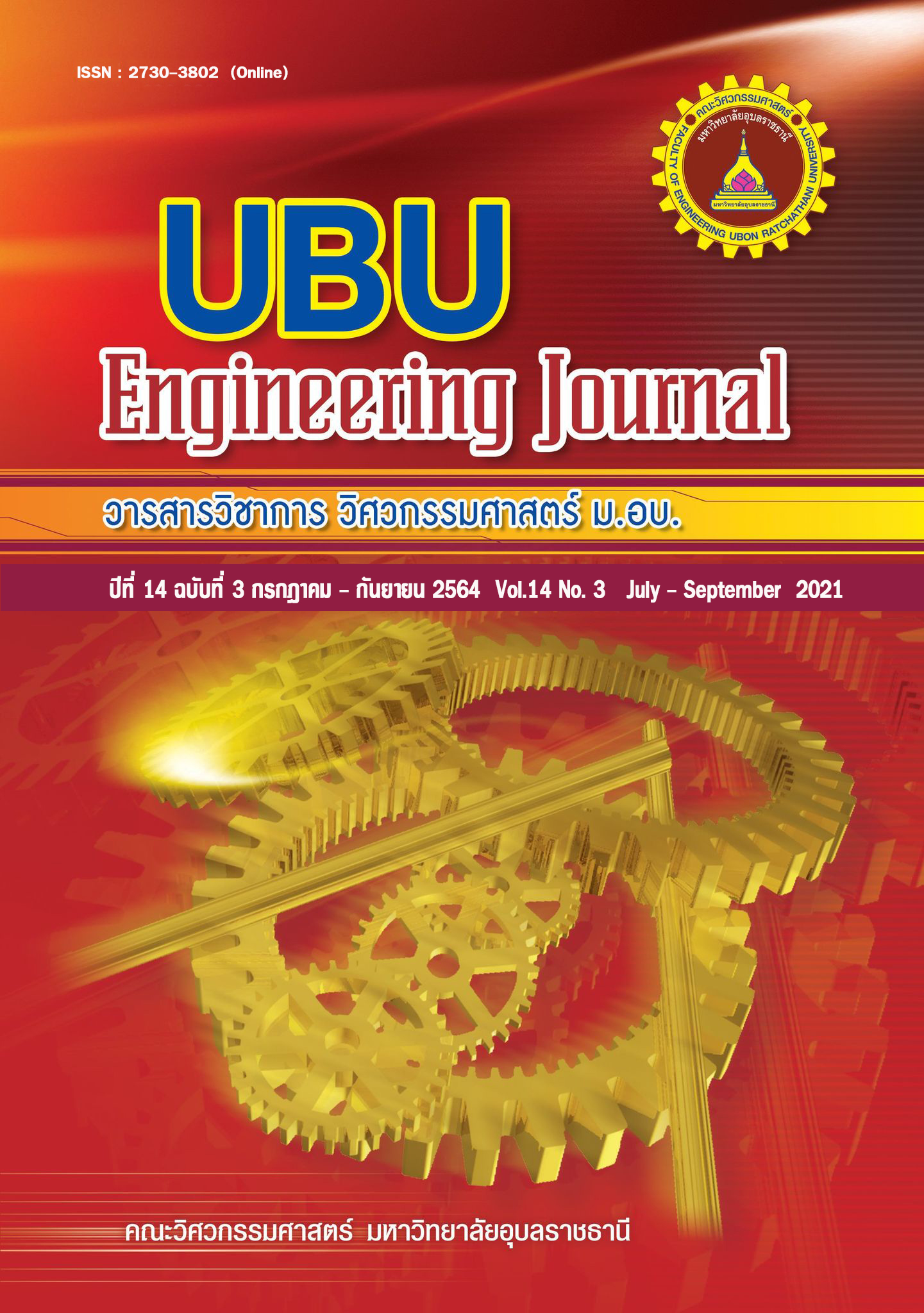ผลกระทบของปูนซีเมนต์ผสมเถ้าลอยบดและเถ้าลอยต่อความต้านทานคลอไรด์ของคอนกรีตภายหลังเผชิญสิ่งแวดล้อมทะเลของไทย
Main Article Content
บทคัดย่อ
บทความนี้มุ่งศึกษาผลกระทบของปูนซีเมนต์ผสมเถ้าลอยบดและเถ้าลอยต่อความต้านทานคลอไรด์ของคอนกรีตภายหลังเผชิญสิ่งแวดล้อมทะเลของไทยเป็นเวลาเจ็ดปี โดยใช้ปูนซีเมนต์ปอร์ตแลนด์ประเภทที่ 1 ปูนซีเมนต์ปอร์ตแลนด์ประเภทที่ 5 ปูนซีเมนต์ผสมเถ้าลอยบด และการแทนที่ปูนซีเมนต์บางส่วนด้วยเถ้าลอยเป็นวัสดุประสานในคอนกรีต ใช้อัตราส่วนน้ำต่อวัสดุประสานเท่ากับ 0.40, 0.50 และ 0.60 และอัตราส่วนเถ้าลอยต่อวัสดุประสานเท่ากับ 0.20, 0.40 และ 0.60 จากผลการศึกษาพบว่า คอนกรีตที่ใช้ปูนซีเมนต์ผสมเถ้าลอยบดและคอนกรีตที่ผสมเถ้าลอยมีความต้านทานการแทรกซึมคลอไรด์สูงกว่าคอนกรีตที่ใช้ปูนซีเมนต์ปอร์ตแลนด์ประเภทที่ 1 และ 5 ทั้งนี้คอนกรีตที่ใช้ปูนซีเมนต์ปอร์ตแลนด์ประเภทที่ 1 มีความต้านทานการแทรกซึมคลอไรด์สูงกว่าคอนกรีตที่ใช้ปูนซีเมนต์ปอร์ตแลนด์ประเภทที่ 5 นอกจากนี้พบว่า ความต้านทานการแทรกซึมคลอไรด์ของคอนกรีตใช้ปูนซีเมนต์ผสมเถ้าลอยบดมีค่าใกล้เคียงกับคอนกรีตที่ใช้เถ้าลอยแทนที่วัสดุประสานร้อยละ 40 สำหรับคอนกรีตที่ใช้คอนกรีตที่ใช้เถ้าลอยแทนที่วัสดุประสานร้อยละ 60 อัตราส่วนน้ำต่อวัสดุประสาน 0.40 มีความต้านทานการแทรกซึมคลอไรด์สูงที่สุด
Article Details
References
[2] Tangtermsirikul S. Durability and Mix Design of Concrete (1st edition). Pathum Thani: Thammasat University, Rangsit Campus; 2003.
[3] Chindaprasirt P, Rukzon S, Sirivivatnanon V. Resistance to chloride penetration of blended Portland cement mortar containing palm oil fuel, rice husk ash and fly ash. Construction and Building Materials. 2008;22: 932 – 938.
[4] ศิระ อาทมาท และทวีชัย สำราญวานิช. กำลังอัดและความต้านทานการแทรกซึมคลอไรด์ของคอนกรีตที่ผสมเถ้าลอยและผงหินปูนและใช้เถ้าก้นเตาแทนที่บางส่วนของมวลรวมละเอียด. วารสารวิศวกรรมศาสตร์ ราชมงคลธัญบุรี. 2562;17(2): 113-125.
[5] มาตรฐานผลิตภัณฑ์อุตสาหกรรม. มอก-2135-2545 เถ้าลอยจากถ่านหินใช้เป็นวัสดุผสมคอนกรีต. 2546.
[6] ASTM G1, Standard practice for preparing cleaning and evaluating corrosion test specimens.
[7] ASTM C39, Standard test method for compressive strength of cylindrical concrete specimens.
[8] Hosein M, Shekarchi M, Tadayon M. Long-term field study of chloride ingress in concretes containing pozzolans exposed to severe marine tidal zone. Construction and Building Materials. 2016;123: 611-616.
[9] Yoo J, Oh B, Park S, Kim S. Chloride penetration resistance properties of concrete containing mineral admixtures. Fracture Mechanics of Concrete and Concrete Structure. 2010.
[10] Sumranwanich T, Tangtermsirikul S. Time-dependent chloride binding capacity of various types of cement pastes. ScienceAsia. 2004;30(2): 127-134.
[11] Leng F, Feng N, Lu X. Experimental study on the properties of resistance to diffusion of chloride ions of fly ash and blast furnace slag concrete. Cement and Concrete Research. 2000;30: 989-992.
[12] Simcic T, Pejovnik S, Schutter GD, Bosiljkov, VB. Chloride ion penetration into fly ash modified concrete during wetting-drying cycles. Construction and Building Materials. 2015.
[13] Ipavec A, Vuk T, Gabrovsek R, Kaucic, V. Chloride binding into hydrated blended cements: Theinfluence of limestone and alkalinity. Cement and Concrete Research. 2013;48: 74-85.
[14] Cheewaket T, Jaturapitakkul C, Chalee W. Long term performance of chloride binding capacity in fly ash concrete in a marine environment. Construction and Building Materials. 2010;24: 1352-1357.
[15] ณัฐพล วงษ์วาร, ทวีชัย สำราญวานิช และ สมนึก ตั้งเติมสิริกุล. ผลกระทบของปูนซีเมนต์ผสมเถ้าลอยบดและปูนซีเมนต์แทนที่บางส่วนด้วยเถ้าลอยต่อความต้านทานการแทรกซึมคลอไรด์ของคอนกรีตภายใต้สิ่งแวดล้อมทะเล. การประชุมวิชาการคอนกรีตประจำปี ครั้งที่ 11, นครราชสีมา, 17-19 กุมภาพันธ์ 2559.
[16] อัญชนา กิจจานนท์. แบบจำลองสำหรับการคำนวณการแทรกซึมคลอไรด์ของคอนกรีตและอายุการใช้งานที่ปลอดการบำรุงรักษาซ่อมแซมของโครงสร้างคอนกรีตเสริมเหล็กภายใต้สิ่งแวดล้อมคลอไรด์. วิทยานิพนธ์วิศวกรรมศาสตรมหาบัณฑิต. สาขาวิชาวิศวกรรมโยธา. คณะวิศวกรรมศาสตร์. มหาวิทยาลัยบูรพา. 2560.
[17] Pavitpok S, Sumranwanich T. Effect of interground fly ash cement and blast-furnace slag cement on chloride diffusion coefficient and compressive strength of concrete under marine environment of Thailand: Proceedings of The 5th Annual International Conference on Architecture and Civil Engineering 2017 (ACE 2017), Singapore: Global Science and Technology Forum; 2017. p.1-10.
[18] Wattanapornprom R, Stitmannaithum B. Comparison of properties of fresh and hardened concrete containing finely ground glass powder, fly ash, or silica fume. Engineering Journal. 2015;19(3): 35-47.
[19] Elsageer MA, Millard SG, Barnett, SJ. Strength development of concrete containing coal fly ash under different curing temperature conditions: Proceedings of 2009 World of Coal Ash (WOCA) Conference, Lexington: USA; 2009. p.1-11.
[20] Harison A, Srivastava V, Herbert, A. Effect of fly ash on compressive strength of Portland pozzolona cement concrete. Journal of Acadamia and Industrial Research (JAIR). 2014;2(8): 476-479.
